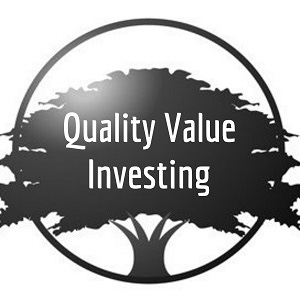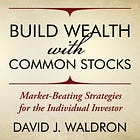Course Module 110: Screening for Quality Business Models
Measuring the company's fundamentals or returns on management

Summary
Investigating how the company’s senior management, in partnership with its stakeholders, is producing and delivering the goods or services is essential.
Remember, we are investing in a company’s human resources as much as the assets, liabilities, and margins on the balance sheet and income statement.
At a minimum, measure the senior management returns on growth, profitability, equity, and capital.
Include the internal customer in your research, as happy employees are inclined to deliver quality products and excellent services, translating to loyal customers and sustainable profit margins.
Focusing on key business fundamentals increases the potential to produce alpha-achieving returns on common stock holdings.
QVI has modeled and implemented five fundamental areas of investment research toward building a market-beating family portfolio for over 14 years: the value proposition, shareholder yields, valuation multiples, downside risks, and in this course module, fundamentals or returns on management.
Although it is advisable to focus on the business’s fundamental structure, the senior management, in partnership with the board of directors, shareholders, employees, customers, vendors, and the community, produces, delivers, and consumes the goods and services.
By keeping investment research focused on a few crucial metrics combined with a pinch of common sense, disciplined investors can outperform sophisticated deep-dive predictive analyses and achieve alpha with lower costs and less risk despite any capital limitations.
Course Module 110 Syllabus
Subject matter objective: Discover prime examples of C-suite-driven metrics of publicly traded companies to analyze toward measuring the fundamentals of quality business models.
How to evaluate a business’s management effectiveness.
Measuring revenue growth, earnings, profit margin, and returns on equity and invested capital.
Analyzing the impacts of the internal customer: the employees.
Assigning a management rating to a researched company.
Investing in the executive’s emotional intelligence.
5 QVI Concentrated Portfolio companies with quality business models.
Remember that numbers don’t lie, whereas humans often do.
Module 110 voluntary action items and suggested resources.
Evaluating Management Effectiveness
Understanding the performance of senior management is paramount to owning slices of excellent companies.
When considering the worthiness of inclusion in a portfolio, examine the actual growth metrics of the company as opposed to speculative forecasts of what might occur with future revenues, earnings per share, free cash flow, or dividend growth. Seek cash-generating companies providing wide, or at least comfortable, margins of safety. Favor businesses with efficient and transparent management, leveraging returns for stakeholders.
Future price targets and other exacting projections are unreliable and best left to market speculators. Therefore, only a select few metrics are necessary to determine management effectiveness toward the potential for market-beating performance.
The challenge of evaluating management and the business model is the propensity to discover inadequacies or even questionable behavior. If we conduct audits of businesses whose shares we own or products and services we buy to eliminate what misaligns our beliefs and values, we manage a light portfolio within a bare-bones lifestyle. Thus, focusing on the management-driven fundamentals of chosen businesses best serves retail investors.
Companies with robust fundamentals producing quality, in-demand products or services are the foundation of an alpha-achieving portfolio; however, we are investing in an organization’s human resources as much as the assets and liabilities listed on the balance sheet, margins on the income statement, and cash flows. Nevertheless, quality companies endure, regardless of the leadership at any given time.
Growth in Revenue and Earnings
Remember to seek companies already growing, regardless of any promises for growth. Evaluate a minimum three-year trailing revenue increase or the compounded annual net sales growth rate.
In addition to revenue growth, look at three-year earnings per share as a critical indicator of the fundamental strength of the company and the commitment to increasing the wealth shared with its owners. Whether measuring growth in revenue or earnings, sift for double-digit—or at least favorable—compounded annualized growth rates (CAGR).
For example, as of the period ending June 30, 2022, the holdings in the QVI Concentrated Portfolio had a cumulative average three-year revenue growth of 7.92 percent. Top-line growth is the primary measure of the potential endurance of an enterprise.
Operating and Net Profit Margins
Is the company profitable?
Only speculators and misinformed investors go long stocks of companies losing money. A no-brainer rule of retail-level investing is that if we never want to lose money, avoid taking long positions in unprofitable businesses. Instead, look at the trailing twelve-month operating margin—EBIT or earnings before interest and taxes, divided by revenue—and net profit margin, or the trailing twelve months of income after taxes divided by sales. Net profit margin is the percent of revenues remaining after paying operating expenses, interest, and income taxes for the trailing twelve months, or TTM, divided by trailing sales, also called NOPAT — net operating profit after taxes.
Again, favor double-digit top- and bottom-line margins or at least superior growth for companies within industries where single-digit margins are the norm. Although rare for large-cap companies, look for higher profit margins, providing cushions against downward macro and microeconomic cycles.
For example, as of the quarter ending June 30, 2022, the constituent companies in the QVI Concentrated Portfolio had a cumulative average net profit margin of 17.04 percent.
*Note: Getting caught up in the math of these complex formulas is unnecessary, as most online brokers and investment websites provide the calculations to the end user at no cost.
Return on Equity
The return on equity (ROE), or how well the company generates net income as a percentage of the total net investment in the stock, is another reliable measure of management effectiveness.
Return on equity is trailing income available to common shareholders divided by average stockholders’ equity from the most recent fiscal year (MRFY) and the year-earlier fiscal period, expressed as a percentage. Return on equity reveals how much profit a business generates from shareholder investment in the stock.
Seek a minimum ROE of 15 percent. As of the quarter ending on June 30, 2022, 15 of the 18 holdings in the QVI Concentrated Portfolios exceeded the 15 percent target, with a cumulative average return on equity of 35.15 percent, more than double the ROE threshold. Nonetheless, be aware of senior management using aggressive stock buybacks at premium stock prices to inflate the return on equity. On the contrary, if executed by the board of directors with sound strategy and at bargain prices, stock repurchases provide a value-add to shareholders of record.
In mergers and acquisitions or when repurchasing shares, companies more often commit the same malpractice as individual investors by overpaying for shares of stock.
Return on Invested Capital
Benjamin Graham taught his students to look beyond earnings per share or EPS and measure return on invested capital or ROIC to see how much a company earns on the capital it deploys from operations.
ROIC is net income after taxes divided by the average of total equity plus the sum of total long-term debt, total other liabilities, deferred income tax, and minority interest, expressed as a percentage.
Graham, along with his most famous student, Warren Buffett, places a premium on the return on invested capital or how well a company allocates its financial resources to generate incremental profits for the business. Target companies that are producing an ROIC of 12 percent or higher.
The return on invested capital is only as reliable as the underlying weighted average cost of the capital or WACC. The weighted average cost of capital considers each category of financial resources in proportion. Sources of capital, including common stock, preferred stock, bonds, and other long-term debt, are included in a WACC calculation. The weighted average cost of capital is the estimated outlay of those resources before returns and, thus, reduces net income.
Return on invested capital demonstrates the ability of management to outperform its capital costs. Thus, an investor must confirm that the ROIC exceeds the WACC by a comfortable margin. Return on invested capital, as it relates to WACC, presents a primary measure of the potential for the enterprise to provide a compounding annual return on the stock price over long periods. When the ROIC diminishes toward the underlying cost of capital, the business faces the inverse threat of a decrease in valuation and an increase in risk.
As of the quarter ending June 30, 2022, the QVI Concentrated Portfolio had a cumulative average ROIC of 14.72 percent against a WACC of 6.96 percent. The ROIC was above the 12 percent target but experienced a significant drop from 22.59 percent before the COVID-19 pandemic. The constituent companies, on average, were deploying capital at over four times its cost before the 2022 second-half fall-out in fundamentals, market-wide from the inflationary bear market.
Return on invested capital is a leading fundamental and margin of safety indicator of Quality Value Investing.
After reading the required disclosures and background information, we’ll continue uncovering how to measure returns on management by exploring the impacts of internal customers, executives’ emotional intelligence, five companies in the QVI Concentrated Portfolio with high-quality business models, and why the numbers never lie, but people do. Course Module 110 concludes with action items and suggested resources.
Disclosure: I/we have beneficial long positions in the common shares of all 18 companies represented by the QVI Concentrated Portfolio in our family portfolio.
I wrote this course myself, and it expresses my own opinions. I am not receiving compensation for it other than from Substack paid subscriptions. I have no business relationship with any company whose stock is mentioned in this module.
Disclosure: David J. Waldron’s Quality Value Investing course modules, research reports, and model portfolios are for informational purposes only. The accuracy of the data cannot be guaranteed. Narrative and analytics are impersonal, i.e., not tailored to individual needs nor intended for portfolio construction beyond his family portfolio, which is presented solely for educational purposes. David is an individual investor and author, not an investment adviser. Readers should always engage in their own research or due diligence and consider (as appropriate) consulting a fee-only certified financial planner, licensed discount broker/dealer, flat fee registered investment adviser, certified public accountant, or specialized attorney before making any investment, income tax, or estate planning decisions.
About the Writer
David J. Waldron is contributing editor of Quality Value Investing and author of the international-selling book Build Wealth with Common Stocks: Market-Beating Strategies for the Individual Investor. David’s mission is to inspire the achievement of his readers’ financial goals and dreams. His work has been featured on Seeking Alpha, TalkMarkets, ValueWalk, MSN Money, Yahoo Finance, QAV (Australia’s #1 Value Investing Podcast), Money Life with Chuck Jaffe, The Acquirer’s Multiple, Amazon.com, Barnes & Noble, Apple Books, the BookLife Prize, and Publisher’s Weekly. David received a Bachelor of Science in business studies as a Garden State Scholar at Stockton University and completed The Practice of Management Program at Brown University.
Bonus: Founding Subscribers of QVI on Substack are eligible to receive a personalized complimentary copy of the case laminate hardcover edition of the book from the author.
Remember the Internal Customer
Keep reading with a 7-day free trial
Subscribe to Quality Value Investing to keep reading this post and get 7 days of free access to the full post archives.





